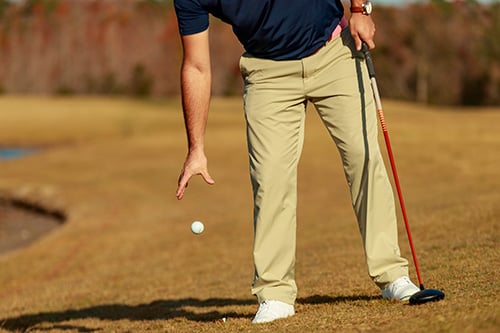
One Rule players of every skill set use on a regular basis is
Rule 14.3 – Dropping Ball in Relief Area.
This Rule tells players how and where a ball must be dropped and what to do if it is dropped in the wrong way, wrong place or fails to
come to rest in the relief area. Finally, 14.3 describes what to
do if a ball dropped in the right way is deliberately deflected by
a person.
The Relief Area is based on three factors:
Reference Point: The point from which the size of the relief
area is measured.
Size of Relief Area: Measured from the reference point, it is
either one or two club lengths from the reference point. (Club length = longest club in your bag, excluding long putters.)
Limits on location of relief area: Must be no nearer the
hole than the reference point and depends on the reason for
the relief:
-Under Rule 16, Abnormal Ground Conditions, Dangerous
Animal Conditions, Embedded Ball, the relief area must be
the same as the area where the ball came to rest (i.e., general
area, bunker etc.). The player must also ensure that complete relief is taken from the condition (i.e., player cannot
play a stroke with their foot on a cart path after taking relief
from the cart path). Under Rule 17, Penalty Area, the relief
area may be anywhere on the course except the same
penalty area.
-Under Rule 19, Unplayable, the relief area can be anywhere
on the course.
Keys to a proper drop:
-The ball must be dropped by the player, or, in a team competition, by their partner.
-The ball must be dropped straight down from knee height.
Spinning, rolling or any other motion affecting where the
ball will come to rest will result in a one-stroke penalty if the
mistake is not corrected.
-The ball must be dropped in and come to rest in the relief area.
-If more than one area of the course is located within the relief
area, the ball must come to rest in the same area of the course
within the relief area that it first touched when dropped.
The key is making sure the ball is dropped where the applicable Rule requires it. This depends on what kind of situation the
player is dropping for (i.e., within one club-length, two clublengths of the reference point or back-on-the-line relief). Note
that when dropping, the Rules don’t differentiate between
fairway and rough.
The player must re-drop the ball if:
1) The ball is dropped by someone other than the player
or partner.
2) Dropped other than knee-height, not straight down, or
hits the player or their equipment before hitting the
ground.
3) The ball doesn’t land in the relief area or on the line when
using the back-on-the-line relief option.
4) The ball is deliberately deflected after hitting the ground.
If any of the above occur, the drop does not count and the
player must drop the ball correctly.
Once a ball has been dropped in the right way and in the right
place, what happens next depends on several things. Quite often
one experiences the need to follow the “two drops and then
place” procedure under – Rule 14.3c(2), wherein a ball properly
dropped, first strikes the course within the relief area, and then
rolls outside it. A ball must then be dropped a second time. If
that rolls outside the relief area, a ball is then placed on the spot
where the second ball first struck the course in the relief area.
Dropping from knee-height may not look like the most
athletic move, but it is designed to retain some of the randomness of where the ball will end up that is not present if a ball is
placed – much like the randomness associated with a ball landing after a stroke. In addition, dropping from knee height results
in the ball embedding less in sand than a ball dropped from
shoulder height.
Now that we know how and where to drop, let’s do it properly
and avoid penalties.
